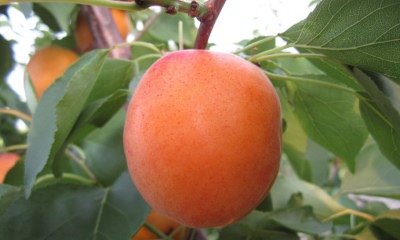
- Authors: USA
- Appeared when crossing: Sun Glo x Perfection
- Name synonyms: Goldrich
- Fruit weight, g: 60-90 (up to 130)
- Fruit shape: oval, slightly flattened
- Skin : thin, elastic
- Fruit color: orange with a slight blush covering 20-30% of the fruit
- Pulp color : pale orange
- Pulp (consistency): dense
- Fruit taste: sweet
The Gold Rich apricot variety is also called Goldrich. A new species of American origin was obtained by crossing Sun Glo and Perfection varieties, it is distinguished by high quality fruits, frost resistance, and resistance to various diseases.
Description of the variety
Gold Rich variety is medium-sized. His crown is spreading and wide. Young growths have a shiny coating, their color is red-brown. The species is self-fertile.
The leaves are dark green. An elongated sharp tip can be seen at their ends. The flowers grow on short stalks. They are solitary, fragrant. Their colors are white. Sepals are pink-red. Flowers appear much earlier than foliage.
Fruit characteristics
The ripe fruits of this variety are quite large. The weight of one such fruit can reach an average of 60-90 grams. Their shape is oval, slightly flattened. The color of apricots is orange with a slight blush.
The skin on ripe fruits is firm and thin. The pulp is pale orange, firm. The stone in apricots is medium or large. It grows partially on the pulp. The shelf life of the fruit is good, the shelf life is up to two weeks. They have a presentable appearance, their marketability is high.
Taste qualities
Ripe apricots have a sweet taste. They are used to be eaten raw.
Ripening and fruiting
Gold Rich variety begins to bear fruit in the second year after planting in open ground. Its ripening dates are early. The fruiting period is late July - early August. The culture bears fruit every year.

Yield
This variety has a high yield. From one adult tree it will be possible to collect an average of 50-60 kilograms of apricots.
Growing and care
Gold Reach should only be planted in well-lit areas near pollinating trees. The best option would be the southern and southwestern slopes. The variety will grow best on loam and sandy loam aerated soils with neutral acidity.
After planting in the soil, like most other varieties, these apricots will require periodic watering, top dressing, and loosening. Remember that trees will grow a lot as they grow, so pruning will also need to be done.
Gold Reach is considered frost-resistant, but it is still recommended to cover the vegetation before the onset of cold weather. This is especially true for those crops that are grown in the northern regions. At the same time, the trunk circle is covered with a thick layer of mulch.



Disease and pest resistance
The Gold Rich apricot variety is considered to be quite resistant to various pests and diseases, including moniliosis. Sometimes trees are still amazed by it. At the same time, young flowers begin to fade, then the disease passes to shoots and branches, leaves. In this case, it is better to immediately use ready-made chemicals.
And also this apricot can be sick with verticillosis. In case of damage, the lower leaves on the trees will begin to gradually turn yellow, then the infection passes into the soil. To cure vegetation, you can apply ready-made fungicides.
Sometimes the culture can be affected by various pests, including the moth, aphids, and leafworms. They can hibernate in small cracks in the trunk or in the soil. To destroy all parasites on plants, it is better to use biological and chemical preparations: "Avant", "Fitoverm", "Skor", "Planthenol". Sometimes they are used as a prophylaxis.

Review overview
Gardeners spoke positively about Gold Rich apricots. It was noted that this species produces large fruits with excellent taste. They all have an attractive appearance.
In addition, according to gardeners, all fruits are distinguished by good transportability, marketability and keeping quality. But at the same time, this species should not be grown in areas with too cold winters, since even in preparation for winter, the plants can simply freeze out. Even wood freezes at too low temperatures.































































